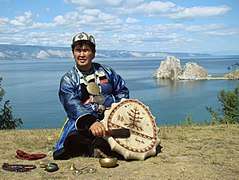Buryats
The Buryats (Buryat: Буряад, romanized: Buryaad; Mongolian: Буриад, Buriad) are a Mongolic people, numbering approximately 500,000, and are the largest indigenous group in Siberia, mainly concentrated in their homeland, the Buryat Republic, a federal subject of Russia. However, some Buryats also live in Mongolia (in the northeast) and in Inner Mongolia in China.[4] They are the major northern subgroup of the Mongols.[5]
ᠪᠣᠷᠢᠶᠠᠳ Буряад Buriad/Buriaad | |
|---|---|
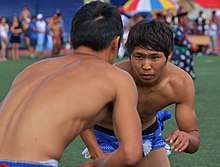 A Buryat wrestling match during the Altargana Festival. | |
| Total population | |
| c. 525,000 | |
| Regions with significant populations | |
| 461,389[1] | |
| 45,087[2] | |
| 10,000[3] | |
| Languages | |
| Buryat, Mongolian, Russian, Chinese | |
| Religion | |
| Tibetan Buddhism, Orthodox Christianity, Mongolian shamanism | |
| Related ethnic groups | |
| Mongols (Barga, Khalkha, Oirats), Tuvans, Khakas, Yakuts | |
Buryats share many customs with other Mongols, including nomadic herding, and erecting gers for shelter. Today, the majority of Buryats live in and around Ulan-Ude, the capital of the republic, although many live more traditionally in the countryside. They speak a central Mongolic language called Buryat.[6] According to UNESCO's 2010 edition of the Atlas of the World's Languages in Danger, the Buryat language is classified as severely endangered.[7]
History

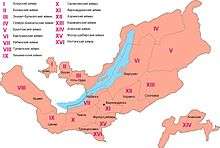

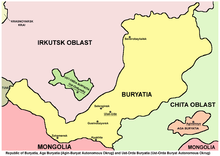

_-_2_men_(Mongols%3F)_carrying_load_on_pole_between_their_shoulders%3B_large_church_in_background_LCCN2004708111.tif.jpg)
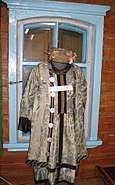
It is most likely that the ancestors of modern Buryats are Bayyrku and Kurykans who were part of the tribal union of the Tiele. The Tiele, in turn, came from the Dingling. The first information about Dingling appeared in sources from the 2nd century BC.[8] The name "Buriyad" is mentioned as one of the forest people for the first time in The Secret History of the Mongols (possibly 1240).[9] It says Jochi, the eldest son of Genghis Khan, marched north to subjugate the Buryats in 1207.[10] The Buryats lived along the Angara River and its tributaries at this time. Meanwhile, their component, Barga, appeared both west of Baikal and in northern Buryatia's Barguzin valley. Linked also to the Bargas were the Khori-Tumed along the Arig River in eastern Khövsgöl Province and the Angara.[11] A Tumad rebellion broke out in 1217, when Genghis Khan allowed his viceroy to seize 30 Tumad maidens. Genghis Khan's commander Dorbei the Fierce of the Dörbeds smashed them in response. The Buryats joined the Oirats challenging the imperial rule of the Eastern Mongols during the Northern Yuan period in the late 14th century.[12]
Historically, the territories around Lake Baikal belonged to Mongolia, Buryats were subject to Tusheet Khan and Setsen Khan of Khalkha Mongolia. When the Russians expanded into Transbaikalia (eastern Siberia) in 1609, the Cossacks found only a small core of tribal groups speaking a Mongol dialect called Buryat and paying tribute to the Khalkha.[13] However, they were powerful enough to compel the Ket and Samoyed peoples on the Kan and the Evenks on the lower Angara to pay tribute. The ancestors of most modern Buryats were speaking a variety of Turkic-Tungusic dialects at that time.[14] In addition to genuine Buryat-Mongol tribes (Bulagad, Khori, Ekhired, Khongoodor) that merged with the Buryats, the Buryats also assimilated other groups, including some Oirats, the Khalkha, Tungus (Evenks) and others. The Khori-Barga had migrated out of the Barguzin eastward to the lands between the Greater Khingan and the Argun. Around 1594 most of them fled back to the Aga and Nerchinsk in order to escape subjection by the Daurs. The Russians reached Lake Baikal in 1643 but the Buryats resisted them and their forces. Howevever, the Buryats were defeated though they attempted to revolt a few times. These revolts were suppressed.[4] The territory and people were formally annexed to the Russian state by treaties in 1689 and 1727, when the territories on both the sides of Lake Baikal were separated from Mongolia. Consolidation of modern Buryat tribes and groups took place under the conditions of the Russian state. From the middle of the 17th century to the beginning of the 20th century, the Buryat population increased from 77,000[15] (27,700[16]-60,000[17]) to 300,000.
Another estimate of the rapid growth in people referring to themselves as Buryat is based on the clan list names paying tribute in the form of a sable-skin tax. This indicates a population of about 77,000 in 1640 rising to 157,000 in 1823 and more than a million by 1950.[18]
The historical roots of the Buryat culture are related to the Mongolic peoples. After Buryatia was incorporated into Russia, it was exposed to two traditions – Buddhist and Christian. Buryats west of Lake Baikal and Olkhon (Irkut Buryats), are more "russified", and they soon abandoned nomadism for agriculture, whereas the eastern (Transbaikal) Buryats are closer to the Khalkha, may live in yurts and are mostly Buddhists. In 1741, the Tibetan branch of Buddhism was recognized as one of the official religions in Russia, and the first Buryat datsan (Buddhist monastery) was built.
The second half of the 19th century and the beginning of the 20th century was a time of growth for the Buryat Buddhist church (48 datsans in Buryatia in 1914). Buddhism became an important factor in the cultural development of Buryatia. Because of their skills in horsemanship and mounted combat, many were enlisted into the Amur Cossacks host. During the Russian Civil War most of the Buryats sided with the White forces of Baron Ungern-Sternberg and Ataman Semenov. They formed a sizable portion of Ungern's forces and often received favorable treatment when compared with other ethnic groups in the Baron's army. After the Revolution, most of the lamas were loyal to Soviet power. In 1925, a battle against religion and clergy in Buryatia began. Datsans were gradually closed down and the activity of the clergy was curtailed. Consequently, in the late 1930s the Buddhist clergy ceased to exist and thousands of cultural treasures were destroyed. Attempts to revive the Buddhist cult started during World War II, and it was officially re-established in 1946. A revival of Buddhism has taken place since the late 1980s as an important factor in the national consolidation.
In the 1930s, Buryat-Mongolia was one of the sites of Soviet studies aimed to disprove Nazi race theories. Among other things, Soviet physicians studied the "endurance and fatigue levels" of Russian, Buryat-Mongol, and Russian-Buryat-Mongol workers to prove that all three groups were equally able.[19]
In 1923, the Buryat-Mongol Autonomous Soviet Socialist Republic was formed and included Baikal province (Pribaykalskaya guberniya) with Russian population. The Buryats rebelled against the communist rule and collectivization of their herds in 1929. The rebellion was quickly crushed by the Red Army with loss of 35,000 Buryats.[20] The Buryat refugees fled to Mongolia and resettled, however, only a few of them joined the Shambala rebellion there. In 1937, in an effort to disperse Buryats, Stalin's government separated a number of counties (raions) from the Buryat-Mongol Autonomous Soviet Socialist Republic and formed Ust-Orda Buryat Autonomous Okrug and Agin-Buryat Autonomous Okrug; at the same time, some raions with Buryat populations were left out. Fearing Buryat nationalism, Joseph Stalin had more than 10,000 Buryats killed.[21] Moreover, Stalinist purge of Buryats spread into Mongolia, known as the incident of L'humbee. In 1958, the name "Mongol" was removed from the name of the republic (Buryat ASSR). Also around 1958, the Mongolian script was banned and replaced by Cyrillic.[4] BASSR declared its sovereignty in 1990 and adopted the name Republic of Buryatia in 1992. The constitution of the Republic was adopted by the People's Khural in 1994, and a bilateral treaty with the Russian Federation was signed in 1995.
The Buryat national tradition is ecological by origin in that the religious and mythological ideas of the Buryat people have been based on a theology of nature. The environment has traditionally been deeply respected by Buryats due to the nomadic way of life and religious culture. The harsh climatic conditions of the region have in turn created a fragile balance between humans, society and the environment itself. This has led to a delicate approach to nature, oriented not towards its conquest but rather towards a harmonious interaction and equal partnership with it. A synthesis of Buddhism and traditional beliefs that formed a system of ecological traditions has thus constituted a major attribute of Buryat eco-culture.[22]
Culture and traditions
Kinship and marriage
Prior to the arrival of the Russians, Buryats lived in semi-nomadic groups scattered across the steppes. Kinship was immensely important in Buryat society, both in spiritual and social terms. All Buryats traced their lineage to a single mythical individual, with the particular ancestor varying based upon geographical region.[23] Kinship also determined proximity, as neighbours were nearly always related.[23] Groups of relatives that inhabited the same grazing land organized themselves into clans based on genealogy. While coalitions between clans did occur, they were infrequent and often relied on looser interpretations of kinship and relations.[23]
Marriage was arranged by the family, at times occurring as early as one to two years old.[24] A unique aspect of traditional Buryat marriage was the kalym, an exchange that combined both bride wealth and a dowry.[24] Kalym involved a husband exchanging an agreed number of head of cattle for his bride, while the bride's family would provide dowry in the form of a yurt and other essential household goods.[24] If a husband did not have enough cattle, a period of bride service would be arranged. Polygamy was permitted, however only men of extreme wealth could afford the price of multiple wives. Marriage ceremonies involved rituals such as the bride stoking the fire in the grooms tent with three pieces of fat, and sprinkling fat upon the clothing of the groom's father.[23]
The arrival of the Russians saw drastic changes to the way kalym system worked. Money became a significant part of the exchange. Over time, the price of a bride significantly increased to the point where "in the 1890s, bride price involved '400 to 600 rubles' in addition to 86-107 head of livestock, when 70 years earlier only the wealthiest Western Buryats gave 100 heads (of cattle)."[25] As the situation worsened, many men engaged in multi-year work contracts with wealthy herd-owners under the promise their employer would aid them in gaining a wife.[24] Later on, the kalym system fell out of favour, and was replaced by marriages arrangements based upon courtship and romantic feelings.
Religion
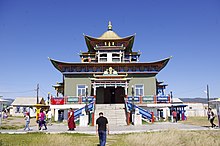
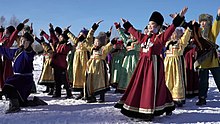
Buryats traditionally practised shamanism, with a focus on worship of nature. A core concept of Buryat shamanism is the "triple division" of the physical and spiritual world.[23] There are three divisions within the spirit world: the tengeri, the bōxoldoy, and lower spirits.[23] These spirits are the supreme rulers of mankind, the spirits of commoners, and the spirits of slaves respectively. In parallel to this is the concept that man is divided into three parts: the body (beye), the "breath and life" of a man, and the soul.[23] The soul is further divided into three parts: first, second, and third. The first soul is contained within the entirety of the physical skeleton, and that damage to it damages the soul. Rituals involving the sacrifice of animals involve great care not to damage the bones, lest the deity receiving the offering reject it.[23] The second soul is believed to have the power to leave the body, transform into other beings, and is stored in the organs. The third soul is similar to the second, differing only in that its passing marks the end of one's life.[23]
A majority of the Buryats are followers of Buddhism. The Buryats converted to Buddhism in the early eighteenth century under the influence of Tibetan and Mongolian missionaries.[4]
Three and multiples of it are deeply sacred to the Buryat. Examples of this numerology include three major yearly sacrifices, shamans prolonging the lives of the sick by three or nine years, the total number of tengeri being 99, and countless other examples.
Shamans are divided into two classes: "great" shamans of arctic regions and "little" shamans from the taiga. Shamans often are associated with nervous disorders, and in some cases are prone to seizure.[23] Shamans can also be divided into "White" shamans that summon good spirits and "Black" shamans that summon malicious ones. Yellow shamanism refers to shamanistic practices that have been heavily influenced by Buddhism. Shamans exist to heal, especially in regards to psychological illnesses.[26] Buryat shamanism is not necessarily hereditary, and other members of the kinship-group can receive the calling (however, shamans do keep records of their lineage, and a descendant is preferred).[23] Shamans could both control and be controlled by spirits.
There are variations in belief between different traditional groups, so there is no consensus on beliefs and practices. For example, Western Buryats along the Kuda river believe in reincarnation of the third soul, likely a result of their exposure to Buddhism.
A minority of Buryats are converts to Christianity. The earliest Orthodox mission was established in Irkutsk in 1731. Although some early converts were motivated by material gain or responded under compulsion, the largest growth has taken place since 1990.[4]
Religion today in the Republic of Buryatia is primarily divided between Russian Orthodoxy, Buddhism, and irreligious.[27] Shamanism has undergone a revival in rural areas since Soviet repression, however it is still small. Those involved practise either Yellow, Black, or a mixture of the two.[28]
Subsistence
Traditionally, the Buryats were semi-nomadic pastoralists. Buryat nomads tended herds of cattle, sheep, goats, and camels.[23] Buryats also relied greatly on local resources to supplement their diets. Following colonization by Russia, pastoralism was gradually replaced by agriculture. The Buryat of today are largely agrarian but most in rural areas still focus on raising livestock as their main way of surviving.
The Buryats located in Siberia are still largely focused on raising livestock due to the shortness of the growing season. They focus on the raising of dairy cattle and the growing of berries to sustain most of their diet. There are also some communities that farm various types of trees and cash crops such as wheat and rye.[29] On the slopes of the Sayan and Altai Mountains, there are communities whose way of life is breeding reindeer.[23]
Mongolian Buryats are farmers as well but are typically semi-settled. They build sheds and fences to keep livestock contained and use hay as their main source of food for the livestock.[30] However, the Buryats located in Buryatia are more focused on the agriculture aspect of farming and not the livestock raising aspect.
Genetics
Distribution of Y-chromosome haplogroups in Buryats:[31]
N-M178=48
C2c-M407=28.8
C-M217 (not M407,M48)=7.3
R1a-M198=4
O2=4
C2b-M48=3.7
R2a=2.6
E=1.3
Haplogroup N-M178 is found mainly among the indigenous peoples of northern Eurasia (Yakuts, Finns).
Among Buryats, haplogroup N-M178 is found mainly in the east.
Haplogroup C3d (M407) is found mainly among the northern and western Buryats, Kazakh Khongirad,[32] Soyots and Hamnigan.
Subgroups

According to the Buryat creation myth, there were 11 Buryat tribes or clans. And according to the myth all 11 tribes are descendants of a man and a mysterious but beautiful creature that turns to swan during day and a woman during the night. After the two married, the man asked her to give him her wings so that she would not turn into swan anymore. However, it is said that after some time the woman asked for her wings back and flew away never to return. Today there are a number of different Buryat tribes, or clans.
Major tribes
- Bulagad - Alagui, Gotol, Sharaldai, Bubai, Khogoi,Erkhidei, Kholtubai, Onkhotoi, Ongoy, Bulut, Barai, Yengut, Buin, Olzoy, Murui, Khulmenge, Khurkhut, Soyot, Noyot, Kharanut, Ashabagat, Abaganat, Buzgan, Dalakhai.
- Khongodor - Ashkhai, Ashata, Kholsho, Uta-Baima, Dasha, Naidar, Nashan, Badarkhan, Boldoy, Terte, Shoshoolog.
- Khori-Buryats - Galzut, Sharait, Khubduut, Gushit, Khuatsai, Khargana, Batanai, Bodonguut, Khudai, Sagaan, Khalbin.
- Ekhirid - Shono, Khengelder, Abzay, Bayanday, Olzon, Segenut, Galzut, Kharbyat, Khaital.
- Sartuul Buryats - Khorchin, Khirid, Khatagin, Saljiud, Batod, Atagan, Khorlid, Onkhod, Khoit, Uriankhai, Khereit.
- Songol
Other tribes
- Dzungar origin - Galzut, Segenut, Ikinat, Bukot, Zamot, Khaital, Zungar, Khuramsha.
- Atagan
- Khamnigan Buryats
- Darkhat
- Khangin
- Khorchin
Notable people
- Olga Kurylenko, actree and model
- Valéry Inkijinoff, French actor
- Balzhinima Tsyrempilov, Russian archer
- Yuriy Yekhanurov, former Prime Minister of Ukraine
- Agvan Dorjiev, Buddhist monk, tutor of the 13th Dalai Lama
- Dashi Namdakov, sculptor
- Irina Pantaeva, first Asian top model
- Yul Brynner, actor
- Orora Satoshi, sumo wrestler
Also see (in Russian) List of Buryats in Russian Wikipedia for more articles.
See also
- Ust-Orda Buryat Okrug
- Agin-Buryat Okrug
- List of indigenous peoples of Russia
- Far Eastern Republic
- Buddhism in Russia
- Shamanism in Siberia
Footnotes
- Ethnic groups in Russia, 2010 census, Rosstat. Retrieved 15 February 2012 (in Russian)
- National Census 2010 Archived September 15, 2011, at the Wayback Machine
- China Radio International, 2006
- Skutsch, Carl, ed. (2005). Encyclopedia of the World's Minorities. New York: Routledge. p. 251. ISBN 1-57958-468-3.
- The New Encyclopædia Britannica, 15th Edition. (1977). Vol. II, p. 396. ISBN 0-85229-315-1.
- "Invalid id". Ethnologue.com. Retrieved 2012-08-13.
- "UNESCO Atlas of the World's Languages in danger". www.unesco.org. Retrieved 2019-04-19.
- Kyzlasov, Leonid (1989). Древняя и средневековая история Южной Сибири (в кратком изложении). Пособие для учителей истории. Abakan. p. 58.
- Erich Haenisch, Die Geheime Geschichte der Mongolen, Leipzig 1948, p. 112
- Owen Lattimore-The Mongols of Manchuria, p. 165
- C.P.Atwood-Encyclopedia of Mongolia and the Mongol Empire, p. 61
- D. T︠S︡ėvėėndorzh, Tu̇u̇khiĭn Khu̇rėėlėn (Mongolyn Shinzhlėkh Ukhaany Akademi) – Mongol Ulsyn tu̇u̇kh: XIV zuuny dund u̇eės XVII zuuny ėkhėn u̇e, p. 43
- University of Pittsburgh. University Center for International Studies, Temple University-Russian history: Histoire russe, p. 464
- Bowles, Gordon T. (1977). The People of Asia, pp. 278–279. Weidenfeld and Nicolson, London. ISBN 0-297-77360-7.
- http://www.bur-culture.ru/index.php?id=news-detail&tx_ttnews[tt_news]=42&cHash=effe903f9ae6737362277ed761d6c2ca Традиционная материальная культура бурятского этноса Предбайкалья. Этногенез и расселение. Средовая культура бурят (Russian)
- Buryats Archived 2006-11-10 at the Wayback Machine
- П.Б. Абзаев. Буряты на рубеже XX-XXI вв. Численность, состав, занятия (Russian)
- Bowles, Gordon T. (1977). The People of Asia, p. 279. Weidenfeld and Nicolson, London. ISBN 0-297-77360-7.
- Hirsch, Francine (2002). "Race without the Practice of Racial Politics". Slavic Review. 61 (1): 30–43. doi:10.2307/2696979. JSTOR 2696979.
- James Minahan-Encyclopedia of the Stateless Nations: S-Z, p. 345
- James Stuart Olson, Lee Brigance Pappas, Nicholas Charles Pappas-An Ethnohistorical dictionary of the Russian and Soviet empires, p. 125
- Esuna Dugarova. Buryatia – a symbol of Eurasia in the heartland of Baikal. UN Special (magazine)
- Krader, Lawrence (October 1954). "Buryat Religion and Society". Southwestern Journal of Anthropology. 10 (3): 322–351. doi:10.1086/soutjanth.10.3.3629134. ISSN 0038-4801.
- NEWYEAR, TRISTRA (2009). "'Our Primitive Customs' and 'Lord Kalym': The Evolving Buryat Discourse on Bride Price, 1880—1930". Inner Asia. 11 (1): 5–22. doi:10.1163/000000009793066596. ISSN 1464-8172. JSTOR 23614933.
- Khangalov, M. (1958). Sobranie sochinenii, torn I & II [Collected Works, vols. 1 & 2]. Ulan-Ude: Buriatskoe knizhnoe izdatel'stvo. p. 57.
- "Coming Together:Buryat and Mongolian Healers Meet in Post-Soviet Reality". www.culturalsurvival.org. Retrieved 2019-04-19.
- "Arena: Atlas of Religions and Nationalities in Russia". Sreda. 2012.
- Shimamura, Ippei, 1969-; 島村一平, 1969- (2014). The roots seekers: Shamanism and ethnicity among the Mongol Buriats. 島村, 一平, 1969. (English ed.). Yokohama, Kanazawa, Japan. ISBN 9784861103971. OCLC 873448431.CS1 maint: multiple names: authors list (link)
- "Family Farming in Russian Regions, Small-Scale Agriculture and Food Supporting Russia's Food Self-Sufficiency : Journal of Small Business and Entrepreneurship Development". jsbednet.com. Retrieved 2019-10-15.
- HÜRELBAATAR, A. “An Introduction to the History and Religion of the Buryat Mongols of Shinehen in China.” Inner Asia, vol. 2, no. 1, 2000, pp. 73–116. JSTOR, www.jstor.org/stable/23615472.
- Харьков В.Н., Хамина К.В., Медведева О.Ф., Симонова К.В., Еремина Е.Р., Степанов В.А. (2014). "Генофонд бурят: клинальная изменчивость и территориальная подразделенность по маркерам Y-хромосомы" (PDF). 50 (2) (Генетика ed.): 203–213. Cite journal requires
|journal=(help)CS1 maint: multiple names: authors list (link) - E. E. Ashirbekov, D. M. Botbaev, A. M. Belkozhaev, A. O. Abayldaev, A. S. Neupokoeva, J. E. Mukhataev, B. Alzhanuly, D. A. Sharafutdinova, D. D. Mukushkina, M. B. Rakhymgozhin, A. K. Khanseitova, S. A. Limborska, N. A. Aytkhozhina, "Distribution of Y-Chromosome Haplogroups of the Kazakh from the South Kazakhstan, Zhambyl, and Almaty Regions." Reports of the National Academy of Sciences of the Republic of Kazakhstan, ISSN 2224-5227, Volume 6, Number 316 (2017), 85 - 95.
Further reading
- Shimamura, Ippei. The Roots Seekers: Shamanism and Ethnicity Among the Mongol Buryats. Kanagawa, Japan: Shumpusha Publishing, 2014. ISBN 978-4-86110-397-1.
- Ethnic groups — Buryats
- J.G. Gruelin, Siberia.
- Pierre Simon Pallas, Sammlungen historischer Nachrichten über die mongolischen Volkerschaften (St Petersburg, 1776–1802).
- M.A. Castrén, Versuch einer buriatischen Sprachlehre (1857).
- Sir H.H. Howorth, History of the Mongols (1876–1888).
- The film A Pearl in the Forest (МОЙЛХОН) illustrates the heavy price paid by the Buryats in the 1930s during the Stalinist purges.
- Murphy, Dervla (2007) "Silverland: A Winter Journey Beyond the Urals", London, John Murray
- Natalia Zhukovskaia (Ed.) Buryaty. Moskva: Nauka, 2004 (a classic general description).
- Buryat Supermodel identifies herself as Siberian Eskimo
- Mitochondrial DNA variation in two South Siberian Aboriginal populations: implications for the genetic history of North Asia.
- Anthology of Buryat folklore, Pushkinskiĭ dom, 2000 (CD)
External links
| Wikimedia Commons has media related to Buryat people. |
| Wikisource has the text of the 1911 Encyclopædia Britannica article Buriats. |

